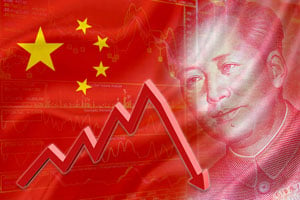The Chinese stock market tumbled another 5.3% today (Monday), causing China's main index to close at a three-and-a-half-month low.
With no intervention from Chinese authorities to calm jittery markets and steady the yuan, the Shanghai Composite Index dropped 5.3% Monday to 3,016.70. Just six trading days into 2016, China's key benchmark has lost 15%.
 A further 3% decline would put the Chinese stock market below its 2,927.29 close from Aug. 26. That low was hit amid a 40% plunge in Chinese stocks over the summer.
A further 3% decline would put the Chinese stock market below its 2,927.29 close from Aug. 26. That low was hit amid a 40% plunge in Chinese stocks over the summer.
The smaller Shenzhen Composite Index plunged 6.6% Monday to 1,848.10.
Monday's rout in Chinese stocks rattled markets worldwide...
Shares in Hong Kong dipped to their lowest level in roughly two-and-a-half years. The Hang Seng Index fell 2.8% to 19,888.50. It was the first time since June 2013 the index closed below 20,000.
Australia's benchmark S&P/ASX 200 fell 1.2%, and South Korea's Kospi declined 1.2%. Japan's market was closed Monday for a national holiday.
Monday's sell-off in the Chinese stock market happened after the People's Bank of China (PBOC) failed to implement new currency easing policies over the weekend. Most investors expected additional intervention from the PBOC after a tumultuous start to the markets in 2016.
And a drop in the country's currency, the yuan, is also driving the Chinese stock market lower today.
In recent weeks, the PBOC has attempted to guide the yuan lower against the U.S. dollar. Such a move has been deemed an effort to boost the appeal of Chinese exports and bolster economic growth. But the central bank's approach has panicked investors who have aggressively sold the currency believing there will be further declines.
While the PBOC didn't announce any new measures Monday, many still expect officials to implement action later this year.
Further interest rate cuts are expected in 2016. In late October, the PBOC stepped up monetary easing with its sixth interest rate cut in a year to combat deflationary pressures and a slowing economy. The amount of reserves banks are required to hold is also expected to be cut by the PBOC.
Here's what investors need to know about the ongoing turmoil in the Chinese stock market...
2016's Glum Start for the Chinese Stock Market
Last week, the Shanghai Composite shed all of its 2015 gains. The index fell 10% in just five trading sessions.
Trading in Chinese markets was halted twice last week by circuit breakers, a market-calming regulatory tool implemented in the country at the start of the week. The circuit breakers were designed to trigger a 15-minute trading halt if the CSI 300 index fell 5%. If that index moved by 7%, trading was halted for the rest of the session.
But the trading halts fueled more fear than calm. Following the halts, investors lined up sell orders when trading resumed and triggered the halts all over again. By week's end, China suspended its circuit breakers. Investors remain guarded and worried over the Asian nation's ability to handle financial turmoil.
The Chinese stock market crash last week unnerved world markets. The MSCI World Index shed 6% last week. The Dow finished the first week of 2016 with a 6.2% loss. The S&P 500 and Nasdaq dropped 6% and 7.3%, respectively.
Today, U.S. markets appeared to shrug off China's sell-off. The three key U.S. benchmarks were mostly flat in early trading.
While the Chinese stock market turmoil is happening thousands of miles away, the crash in stocks still has a major impact on your money...
[mmpazkzone name="in-story" network="9794" site="307044" id="137008" type="4"]
Stay informed on what's going on in the markets by following us on Twitter @moneymorning or liking us on Facebook.
Related Articles:
- CNBC: China Shares Tumble in Late Trade as Asia Markets Sell Off
- CNN Money: China Stocks Start New Week with 5.3% Drop
- The Wall Street Journal: China Market Set the Global Tone - Recap


